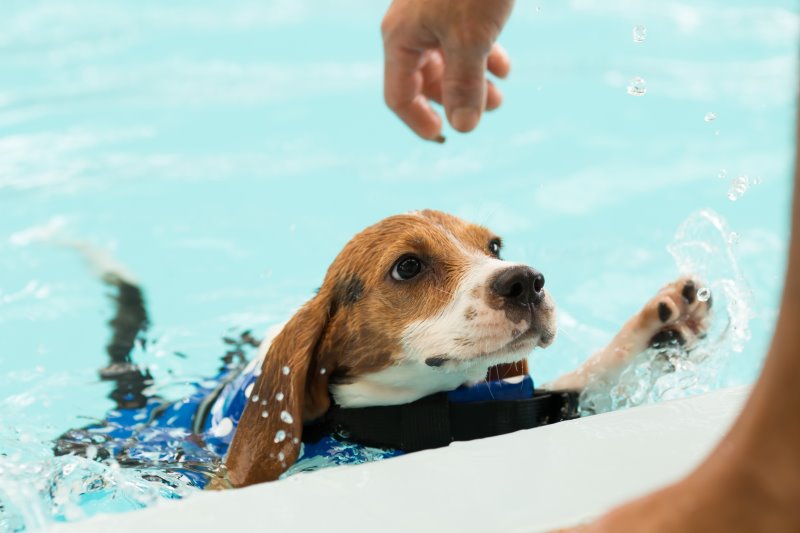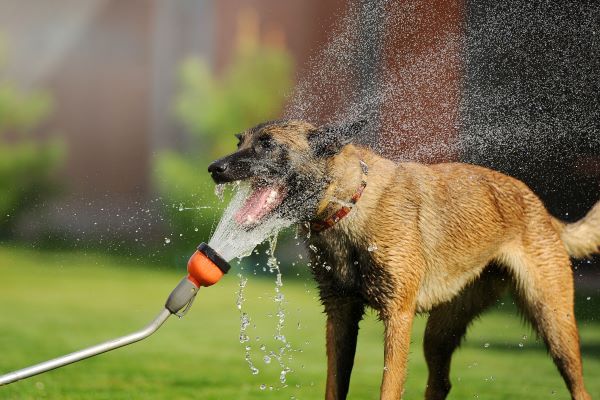Outdoor adventures with dogs: Summer fun, exercise and play
Summer is the perfect time for some fun outdoor adventures with our pooches… hiking through a shady forest, frolicking in the ocean, visiting a new dog park or paddling in a kayak…

We all know that exercise is essential for our dogs, but during the summer months when the mercury climbs skyward, it can be uncomfortable—and even at times dangerous—for our dogs.
That’s why we’ve compiled some super summer activities and top tips for keeping your pooch active and engaged during the peak of the season. Whether by moderating your daily walk to suit the conditions, to going for a swim or engaging in some fun water play, there’s sure to be something to suit every dog and its owner! Keep in mind that having a broad range of exercise options will help you keep your dog fit and happy, whatever the weather.
1. The daily walk
Walking remains the favourite exercise of most dog owners, and of course it’s great for dogs too! Taking your dog for a daily walk is not just good physical exercise for both of you, it also provides plenty of mental stimulation for your pooch as they get to see and smell new places, people and other animals.

Tips to keep summer walks as enjoyable as possible:
- When the mercury climbs, be sure to modify the duration and intensity of your walk to suit the conditions and consider personal factors such as your dog’s age, breed and general health. Flat faced breeds like bulldogs and pugs, as well as puppies and senior dogs, can really struggle in the heat, and you can’t be too cautious when the temperature soars, even if it means taking frequent rests in the shade or forgoing your walk altogether.
- On hot days, it’s best to head out in the early morning or evening, when the temperature is usually cooler.
- Keep to the most shaded streets and paths or make your walk less strenuous by slowing your pace to a gentle amble and avoiding steep hills. Walks don’t have to be long and time-consuming to offer some benefit – just 15 minutes of ambling around the block will provide a change of scenery and a welcome opportunity to sniff, explore and meet and greet other dogs and owners along the way.
- Take water with you if there are no taps or water fountains on your route. You can also use it to cool down a very hot dog by gently spraying or splashing their paws and stomach. A portable bowl or a doggie drink bottle with a bowl-like attachment will make it easier for her to have a proper drink.
- Walk on dirt paths and grass verges rather than hot pavement. You can check if the pavement is too hot for your dog’s paws by holding the back of your hand to the ground. If you can keep it there for 5 seconds, it’s safe to walk your pooch. If not, you’ll run the risk of burning their paws.
- Watch your dog for signs of over-heating, e.g. panting, drooling and fatigue
Learn more: Pets that suffer in summer: how to keep them cool
2. The forest hike
If you and your dog are generally fit and healthy and you both love a long walk, consider hopping in the car and heading for a dog-friendly state forest or reserve in your region. We recommend that you check the weather forecast first; forests are great for summer hiking because they are typically well shaded, but if it’s a real scorcher, or there is a high fire danger or a storm is approaching, they are best left for another day.
Tips to get the most from a forest hike adventure:
- Before setting out to your chosen forest, check the relevant website to make sure dogs are permitted and if any rules or restrictions apply. Also check the signs when you arrive, as these may provide different or updated information.
- Remember that the rules are there for a valid reason, for example, if dogs are to be on a lead at all times, it is often because of vulnerable native wildlife in the region. Only allow your dog off-leash in designated off-leash areas and only if she is 100% obedient and will return to you when called.
- Of course, make sure that fresh drinking water is available, and take your own as well just in case (for your dog and yourself). Also take along food or snacks, a pet first aid kit and waste bags (and pick up after your dog, even in the most remote areas. If rubbish bins aren’t provided, you’ll need to take all your rubbish with you when you leave).
- Be aware if you are venturing into an area prone to fleas or ticks, in which case you will need to examine your dog carefully for these parasites after the hike. You may also need to look out for other possible dangers along the trail, such as snakes and poisonous plants.
Where to hike:
- NSW – dogs are allowed in all state forests. See the complete list of NSW state forests here.
- VIC – dogs are permitted in all state forests except for Murrindindi Scenic Reserve. See here for further information.
- QLD – dogs are allowed in some state forests, parks and recreation areas. See here for more information.
- SA – dogs are allowed in certain parks and forests. See more information here.
- TAS – some reserves permit dogs. Find more information here.
- WA – some reserves permit dogs. Find more information here.
3. Swimming
Swimming and water games are an excellent way to exercise and engage your dog in the heat. You don’t have to worry about your dog overheating if your play extends for a longer period of time than usual. Also, swimming requires a lot of exertion from dogs so it will leave those who enjoy it both tired and happy!

Many dogs love the water, but some absolutely hate it, even those whose are supposed to be water friendly by virtue of their breed! My friend has a Poodle named Thorpy, after the legendary Australian swimmer Ian Thorpe. Ironically, Thorpy detests the water and won’t set a foot in it, even at the local dog beach, where he sticks firmly on the sand. My rescue Staffie-cross has a love-hate relationsip with water – he will happily run into the shallows to chase other dogs and retrieve balls, but he refuses to go any deeper than where he can comfortably stand, and cannot be coaxed even onto the steps of a swimming pool!
 For dogs who do enjoy it, swimming can be an excellent – and cooling – form of exercise, providing a good cardio workout and strengthening muscles. In particular, swimming is great for dogs with joint problems, as it provides low-impact exercise. A life jacket or dog flotation device can give your dog a sense of security and help her stay in the water longer for an optimum cardio workout. Dog life jackets are intended to be used as an aid, and should not be relied upon to keep your dog safe; they are never a replacement for a pair of human eyes.
For dogs who do enjoy it, swimming can be an excellent – and cooling – form of exercise, providing a good cardio workout and strengthening muscles. In particular, swimming is great for dogs with joint problems, as it provides low-impact exercise. A life jacket or dog flotation device can give your dog a sense of security and help her stay in the water longer for an optimum cardio workout. Dog life jackets are intended to be used as an aid, and should not be relied upon to keep your dog safe; they are never a replacement for a pair of human eyes.
If your dog hasn’t ventured into the water before, don’t assume that she “knows” how to swim. Not all dogs are natural swimmers, and some, like Bulldogs and Pugs, are not well-suited to swimming and should avoid deep water. However, in most cases, teaching your dog how to swim is well worth the effort.
Learning to doggie paddle
- We recommend that you introduce your dog slowly to swimming, starting off in a paddling pool or in the shallows at the beach or lake. Stay close by and praise or reward her for entering the water. If she’s reluctant, try coaxing her with a ball or favourite toy, but never force her in against her will.
- When she’s comfortable in shallow water, progress to a swimming pool with steps that are large enough for her to stand on and be sure to give her plenty of encouragement to get in. You’ll need to hop in first and stay in the water with her the whole time.
- When she seems comfortable standing in the water, place your arms under her belly and encourage her to move off the steps. Help her paddle by holding your arms under her belly until she manages on her own. Then teach her to swim back to the steps so that she knows how to get out of the pool on her own.

Some dogs may just be chill enough to lounge on a lilo! Our Twiggy was reluctant at first, but after lots of encouragement, she really took to floating Zen-like on a water cushion!
If you don’t have a swimming pool, or your dog doesn’t like to swim in it, a shallow plastic paddling pool, clam shell or other water container placed in a shady spot can be a great alternative for your dog to climb into on a hot summer’s day. Make sure that your pooch is able to lie comfortably in it with her head above the water, as otherwise there is a risk of drowning.
Shallow pools are great for a cooling soak and can also be used for some stimulating interactive play. If your dog is hesitant to climb in, try adding some fun toys to the pool and encourage her in by splashing around in it yourself.
Swimming safety tips:
- Never leave your dog unattended in a pool, even if she can swim confidently on her own. Dogs should be supervised when swimming in any type of pool in which their feet can’t touch the ground because they can accidentally drown if they can’t figure out how to get out on their own.
- Some dogs view the swimming pool as their own personal giant-sized water bowl. Drinking excessive pool water can be harmful, so have plenty of fresh drinking water close by and do your best to discourage them from drinking from the pool.
- Check your dog after swimming for any skin reactions (such as itching, redness or flaking) to the chemicals in the pool water.
- If you have any concerns about your dog’s suitability for swimming, consult with your vet first.
- For more pool safety tips see Summer safety with your pet.
4. The dog beach
If you live near the coast, a popular summer exercise option is to visit a designated “dog beach” where dogs are permitted to be off leash. Most dogs will enjoy running on or digging in the sand and splashing in the shallows, all of which will provide a great workout and lots of stimulation. You can also use a visit to the beach as an opportunity to practise recall (it’s particularly important that your dog responds to your call in this environment) and play fun interactive games together, such as burying a ball or toy in the sand for her to find.

Tips to get the most from a dog beach outing:
- If your dog is keen to venture into the water, make sure to keep close by, watch her at all times and to be fully prepared to swim with her or to jump in after her if she appears to be getting into any trouble. Also, make sure your dog doesn’t ‘over-do’ the swimming – too much of a good thing can turn into an emergency trip to the vet with a dog who has swallowed excessive sea water.
- Don’t forget to take fresh drinking water, dog treats (keep them in an airtight container) an umbrella or shade cover and extra towels for drying your dog. A cover for your car’s back seat is a good idea, or be prepared for a wet and sandy vehicle when you leave. We recommend that you purchase a dog floatation device or life vest if you are planning to make this a regular excursion.
- Some “dog-friendly” beaches have particular days of the week or times of the day when dogs are allowed, or there may be certain areas of the beach where dogs are permitted. Check the internet for the specifics regarding dog beaches in your region. Be mindful of those visiting the beach without dogs and keep your dog away from other people’s possessions.
- If you don’t live near an ocean dog beach, see if there is a river, lagoon or other body of water where dogs are permitted.
Where to find a dog beach:
5. Water games
Water games and activities are a great option for summer fun as they allow your dog to play outdoors for while staying cool. Even dogs that don’t like water may find a water activity that they enjoy, especially after a bit of encouragement and if you and other family members or friends join in the fun. Some water games do not require your dog to submerge themselves in water or get completely soaked, so dogs that don’t enjoy swimming can also enjoy them.
Here are a few of our favourite interactive water games:
Bobbing for toys or treats
Bobbing for highly desirable items in a shallow pool or large container is a fun game that will also help to get your dog comfortable putting her head under the water. Try using a ball or waterproof toy, or if your dog is very food-driven, you can use small food-dispensing toys with treats inside.
A good idea is to start off with an item that will float on the surface. If your dog enjoys this game, you can purchase weighted pool toys that will sink slowly to the bottom of the pool. These can also be used to entertain dogs that are happy to swim in a full-size pool.
Water fetch
Take a ball or toy with you to the dog beach and play a gentle game of fetch at the water’s edge or in the shallows for a great workout while keeping cool. For dogs who are reluctant to go into the water, playing fetch can be a good way to entice them in on their own accord – simply begin the game on the dry sand or grass verge and gradually progress towards the shallows, until you are both standing in the water or she is venturing into the water to retrieve the ball.
If your dog is already a confident swimmer, throw the ball into the water to a point where they must swim to reach it. Not only will a game of water fetch tire your dog out in double time, they will keep nice and cool while playing it! (Don’t over-do it though – a highly repetitive and fast paced activity like fetch can put undue pressure on the joints and ligaments that can lead to an injury.)
Turn on the sprinkler or hose
A plain old sprinkler is a great “toy” for simple summer fun, while sprinklers that move are terrific for dogs who enjoy a chase! They offer dogs who are less inclined to go for a swim the opportunity to play and enjoy the water.

If you have a lawn, turn on the sprinkler and encourage your dog to run through the water – and you will be watering your garden at the same time. You can even create a sprinkler agility course using multiple sprinklers and hoses placed around your yard. This is a great way for you to play with your dog and keep cool in the process. Run through the sprinklers yourself and encourage your dog to join you!
Get out the water gun
You can play water tag using a toy water gun by encouraging your dog to chase after the stream. If she gets too hot, you can use it to hose her down as well. This is a great way to make water games more portable; for apartment dwellers, you can take the water gun with you to the dog park, as long as there as a tap available for refills. This game is a fun way to engage the whole family in some water play as well!
6. Water sports with dogs
For water sport enthusiasts, sharing your chosen activity with your canine companion can take your enjoyment to a whole new level. However, you’ll need plenty of patience and your pooch will need plenty of practice before the fun can really begin.
Kayaking / canoeing
Going out in a kayak or canoe with your dog can provide both of you with hours of peaceful enjoyment and relaxation. You can use treats to teach your dog how to get in and out of the kayak whilst still on land, then practise in shallow water until your dog is at ease. Your dog will need to be able to sit still so that you don’t overbalance, so if she is very excitable or can’t sit still for long periods, it may not be the sport for her. Smaller breeds can sit at the front, whilst larger dogs might be more comfortable closer to your feet (always have them seated in front of you so you can see what they’re up to).

This is a great activity to do in inlets, small bays and slow-moving rivers where there isn’t too much traffic. If you’re going down a river, you should check the terrain first to ensure there aren’t troublesome rocks or strong currents ahead. A canine floatation device with a handle for gripping is essential and will give you peace of mind in case your dog falls overboard.
Stand-up paddling / Paddleboarding
Paddleboarding is a fun water sport that you and your dog can do together as the big board allows plenty of space for a canine companion. However, you probably shouldn’t bring your pooch along unless you’re an experienced paddleboarder yourself.
For your first attempt out together, we recommend you pick a very quiet day on a lake or bay, to let your dog get used to the new experience in calm and pleasant conditions. Practice having her sit on the board on dry land first, and then in shallow water, before you head away from the shore.

As you both will probably end up in the water, your dog should wear a life jacket with a handle, which will also make it easier for you to lift her back on the board. If you have difficulty balancing with your dog on the board, you can try paddling on your knees to lower your centre of gravity.
Dog Surfing
If you and your dog love the sea and are experienced swimmers, why not introduce her to the sport of surfing? You’ll need to start very slowly by encouraging her onto the board on land first, then in very shallow water, then in very small waves. We recommend that you always use a properly fitting canine floatation device – even experienced surfers (both human and canine) can get tumbled or caught in a rip.

You can rent a suitable board at your local surf shop. You may want to start with a long board as it is easier to balance on, or you could try a boogie board for a very small dog. If your dog is keen for more, there are special dog surfboards which are designed to be easier for them to grip, and there are even surf schools that will teach you and your pooch how to balance on a board.
Diving Dogs / Dock Diving
If your dog loves water, is an experienced swimmer and loves to retrieve, she will probably excel at the sport of Diving Dogs, also known as Dock Diving. This popular aquatic sport entails throwing a toy into the water while the dog waits on a dock. The dog must then run and jump into the water to retrieve the toy. Dogs are judged by the length, height and/or speed of their jump.

If competitive sports aren’t your thing, you can play “dock diving” with your dog by tossing his favourite toy into a swimming pool and encouraging him to jump in and retrieve it. This is the ultimate game of fetch, and breeds like Labradors and Golden Retrievers may just go crazy for it! For experienced canine swimmers, retrieving items underwater is a fun and challenging sport. Weighted toys suitable for diving and aquatic play can be purchased online or in stores.
In summary
 Exercising your dog every day is essential in ensuring her ongoing physical and mental health, and having a variety of exercise options that can be adapted to suit the weather conditions will help you meet her needs. This is particularly important in summer, when extreme heat can play havoc with your usual routine and lead to a bored and under-stimulated dog.
Exercising your dog every day is essential in ensuring her ongoing physical and mental health, and having a variety of exercise options that can be adapted to suit the weather conditions will help you meet her needs. This is particularly important in summer, when extreme heat can play havoc with your usual routine and lead to a bored and under-stimulated dog.
Summer is the season to be resourceful, adaptable and adventurous! Try out some new activities – and a whole lot of water fun and games – that are designed to beat the heat. Take your dog swimming or for a play at a dog-beach, turn on the garden hose or buy a water-gun, or get creative with you own ideas for other cool and cooling activities to do with your dog this season.
Bow Wow Meow Pet Insurance can help protect you and your dog should an unexpected trip to the vet occur.
-
Find out more about our dog insurance options
-
Get an online pet insurance quote
Bow Wow Meow is proud to have been awarded winner of Canstar’s ‘Most Satisfied Customers’ Award in the Pet Insurance category for both 2024 and 2025!
Bow Wow Meow is proud to have been chosen as Product Review’s Pet Insurance Award Winner every year from 2018 to 2025! This is based on 2,995 independent customer reviews (as at 21/01/2025), with an overall rating of 4.3*
Google Review rating = 4.5* (based on 968 reviews)
Trust Pilot rating = 4.6* (based on 531 reviews)
Bow Wow Meow is proud to have been chosen as Product Review’s Pet Insurance Award Winner every year from 2018 to 2025! This is based on 2,995 independent customer reviews (as at 21/01/2025), with an overall rating of 4.3*
Google Review rating = 4.5* (based on 968 reviews)
Trust Pilot rating = 4.6* (based on 531 reviews)
Bow Wow Meow has been chosen as a winner in the Finder Pet Insurance Awards 2024. Finder’s panel of experts analysed over 140 quotes to award our Ultimate Care Plan the winner of the “Pet Insurance – Value” category.










